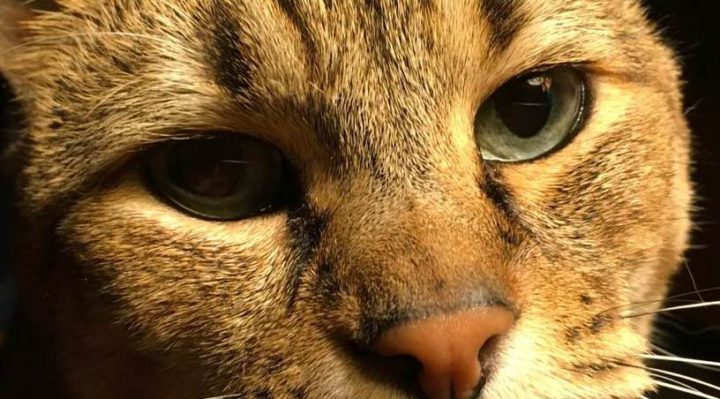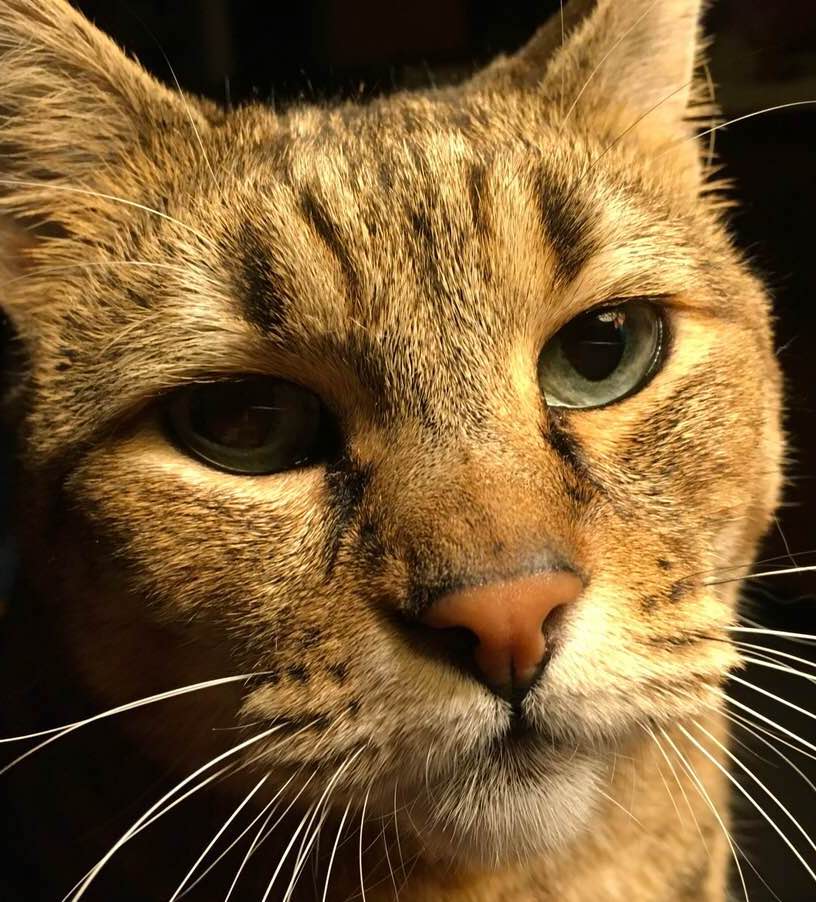
You’ve worked with your cat introducing a collar, then a collar with tags. You’re satisfied that she’s accepted the collar as something safe to be around. Your patience so far has been rewarded!
You might be concerned that the cat’s attitude could change when you buckle the collar around her neck for the first time. That’s a reasonable concern. For your cat, wearing a collar may be a more alarming experience than “meeting” a collar.
You will not, however, simply buckle the collar on the cat’s neck and walk away from her, job done! Remember that you’re working up to helping your cat learn to wear a harness happily. Wearing a collar happily is one of the first steps.
Prepare the collar before you put it on the cat.
 Practice buckling and unbuckling it. The mechanisms of new collars can sometimes open and close reluctantly. Work out the kinks.
Practice buckling and unbuckling it. The mechanisms of new collars can sometimes open and close reluctantly. Work out the kinks.
 Make extra holes as needed, if it’s a buckle collar. It’s much easier to do that off the cat.
Make extra holes as needed, if it’s a buckle collar. It’s much easier to do that off the cat.
 Consider covering multiple tags with tape to mute the noise they can make knocking together when the cat moves.
Consider covering multiple tags with tape to mute the noise they can make knocking together when the cat moves.
Putting the collar on the cat for the first time should not involve buckling it. Yes, be even more patient!
When the cat is relaxed next to you, unrestrained, go through some of your “introduction to the collar” moves with her, letting the collar touch her, pulling it gently across her back. Work up slowly to putting it on but not completely around her neck. Do not fasten it or pull it tight.
Your cat should not see this contact as anything less “safe” than your other collar moves. If she is concerned, back up a few steps to work more with the collar close to her and touching her, but not around her neck.
When the cat has clearly accepted the collar around her neck, make the moves you will when fastening it, but don’t actually fasten it. Leave it loose around her neck.
Does it fall off when she moves, stands up, leaves? Does that seem to bother her? Does she jump away, surprised or fearful?
Work with “dropping” it near her when she is in one of her happy places. Start far enough away to avoid alarming her, move closer as she comes to accept the noise, fast movement, or whatever is bothering her about a dropped collar.
You are helping her learn it will not hurt her or be unsafe.

Photo by Mary Cole
You’ve been very patient so far. You’ve taken the time needed to give your cat a good impression of the new collar. Now you’re finally ready to fasten the collar around your cat’s neck . . . but don’t be hasty. Patience is still necessary!
 Fasten the collar, then immediately unfasten it.
Fasten the collar, then immediately unfasten it.
 Take the collar off the cat’s neck and interact in another way the cat enjoys.
Take the collar off the cat’s neck and interact in another way the cat enjoys.
 Repeat the process—collar around neck, collar fastened then unfastened, then some other enjoyable interaction—off and on throughout the few minutes you spend working with the cat.
Repeat the process—collar around neck, collar fastened then unfastened, then some other enjoyable interaction—off and on throughout the few minutes you spend working with the cat.
You can do as many short “training” sessions as you wish throughout the day, as long as you have the cat’s cooperation. Always quit, if at all possible, before the cat stops cooperating!
Give the cat a chance to spend time with you, too, if the cat wants, without any training going on. Just the two of you sitting together watching TV or whatever you both enjoy. Interactions should not be all training.
Your cat should become accustomed to having the collar put around her neck, fastened, then immediately unfastened.
When that’s comfortable for her, the next step is to leave the collar fastened (with your hands still on the collar and the cat not trying to leave) for a count of one. Then two . . . and so on.
When you can leave the collar fastened for a count of, say, ten, experiment with moving your hands a few inches away from the collar. Maybe one hand at a time? I’ll leave the logistics up to you. Your goal is to remove your hands from the collar completely, ideally with the cat holding still.
However, it’s very likely that, with your hands removed even only a little bit, the cat will move—casually or with conviction—and boom, you have a cat walking (or running) around the room wearing a collar. There’s only so much you can control in this situation.
I suggest you practice separately, ahead of time, an informal cat “recall”—either you call the cat to come to you, or the cat learns to hold still while you come to her. Also practice a “pick-up,” in which the cat learns to accept your leaning over her, picking her up, and holding her or placing her somewhere.
Your objective in practicing these other behaviors is that when your cat is running around wearing a collar for the first time, she will allow you to pick her up, settle her, then remove the collar.
You do want her settled when you remove the collar, not thrashing around out of fear or frustration. That’s why the acceptance of being picked up is a very important skill for a cat to learn. You and your cat will work that part out.
Pick her up, settle her, unfasten the collar, do some more interactions that are pleasant for her, then let her go. You do not want the cat to see the unfastening of the collar as an “end of the fun” signal. Taking the collar off does not mean you’re done.
Repeat in short sessions, letting the cat walk around in the collar longer and longer as she comes to accept it. You will decide for yourself if eventually you’d like the cat to wear the collar all the time.
For indoor cats with no chance of escape to the outside, a collar for ID purposes may not seem necessary, especially if the cat is microchipped (which all cats should be). You may choose to have your indoor cat wear a collar with ID tags only when you take her out of your home (like when she learns to walk happily on a harness and you take her to the park). It’s your choice.
For cats that free-roam outdoors, an ID collar is always recommended and the cat should be microchipped. A breakaway collar is often safest, although you may lose the ID.
Cats that eat and/or drink out of metal dishes can be alarmed by the banging of the ID tags hanging from their collar on their bowls. Taping the tags together can help. There are also commercially made “tag covers” or “tag pouches” available in a variety of sizes and materials to silence and protect the tags.
Observe your cat closely as she wears her collar around the house. If those tags banging on her metal bowl are bothering her enough that she’s stopped eating or drinking, do something about it! Also, collars can get caught and cats can end up “wearing” your favorite afghan. That calls for a quick rescue and a follow-up collar repair to avoid any further damage to cat or coverlet.
Is it possible that, even after all the good work you’ve done with her, your cat will decide that she must somehow get out of the collar? That could happen.
Watch closely. You might feel that the cat is genuinely frightened, even if you can’t guess what about wearing a collar around her neck causes that response. Check to make absolutely sure she’s not acting frightened because something about the collar is causing her discomfort, like fur caught on Velcro, for example. Fix it if you find that’s the case.
Maybe your cat isn’t acting fearful, but maybe . . . as if she doesn’t want to wear the collar? You can’t know for sure why she’s acting as she does, but you can try to figure it out.
Back up in your training to a point that the cat displays acceptance of the collar—not on her, maybe not even near her—and start to work your way through the steps again.
If you’re concerned at any point because your cat’s reaction to the collar seems extreme, consult your veterinarian. Eliminating the possibility that a physical issue is prompting the behavior is always the best first step. Your veterinarian may also be able to recommend a source of more information on cat behavior, or even a local trainer who deals with cats as well as dogs. You can also contact reputable trainers outside your area for online consultations.
Luckily, if you’ve had the cat’s consent throughout the training process, you will probably find she continues to cooperate once the collar is around her neck and fastened. Cats with “collar issues” are not a large percentage of the pet population, and cats that have been taught to accept their collars through patient positive training usually don’t object to wearing those collars at all.
Now, are we ready for a harness?
Yes!
Do your due-diligence on harness purchase. Many styles, sizes, and fabrics are available.
 Read some articles online first to figure out which style of harness will be best for your cat.
Read some articles online first to figure out which style of harness will be best for your cat.
 You won’t know for sure until you try it. Most pet equipment suppliers offer at least a store credit when you return a product that doesn’t fit or doesn’t work for your pet, but researching before you choose is always a good idea.
You won’t know for sure until you try it. Most pet equipment suppliers offer at least a store credit when you return a product that doesn’t fit or doesn’t work for your pet, but researching before you choose is always a good idea.
 Ask friends with cats that wear harnesses!
Ask friends with cats that wear harnesses!
 Shop at a locally owned pet supply store where you (without your cat) can ask questions and see how various harness styles work. They often have stuffed-animal “cats” so you can test out the various styles “for real”!
Shop at a locally owned pet supply store where you (without your cat) can ask questions and see how various harness styles work. They often have stuffed-animal “cats” so you can test out the various styles “for real”!
Fit is another sticky issue. Here’s where all your handling practice makes your job much easier!
 Measure the cat as directed by the harness manufacturer. Every one is different.
Measure the cat as directed by the harness manufacturer. Every one is different.
 Use either a soft measuring tape (like for sewing) or a piece of string you can mark, then measure when it’s off the cat.
Use either a soft measuring tape (like for sewing) or a piece of string you can mark, then measure when it’s off the cat.
 You won’t be able to adjust all the various parts until the harness is actually on the cat, so do the best you can before that with accurate measurements and good eyeballing.
You won’t be able to adjust all the various parts until the harness is actually on the cat, so do the best you can before that with accurate measurements and good eyeballing.
As you may have guessed, you won’t be fastening that harness on your cat for quite a while yet. You’ve got some more work to do before that!
Next week, introducing the harness to your cat with patient, positive training.



